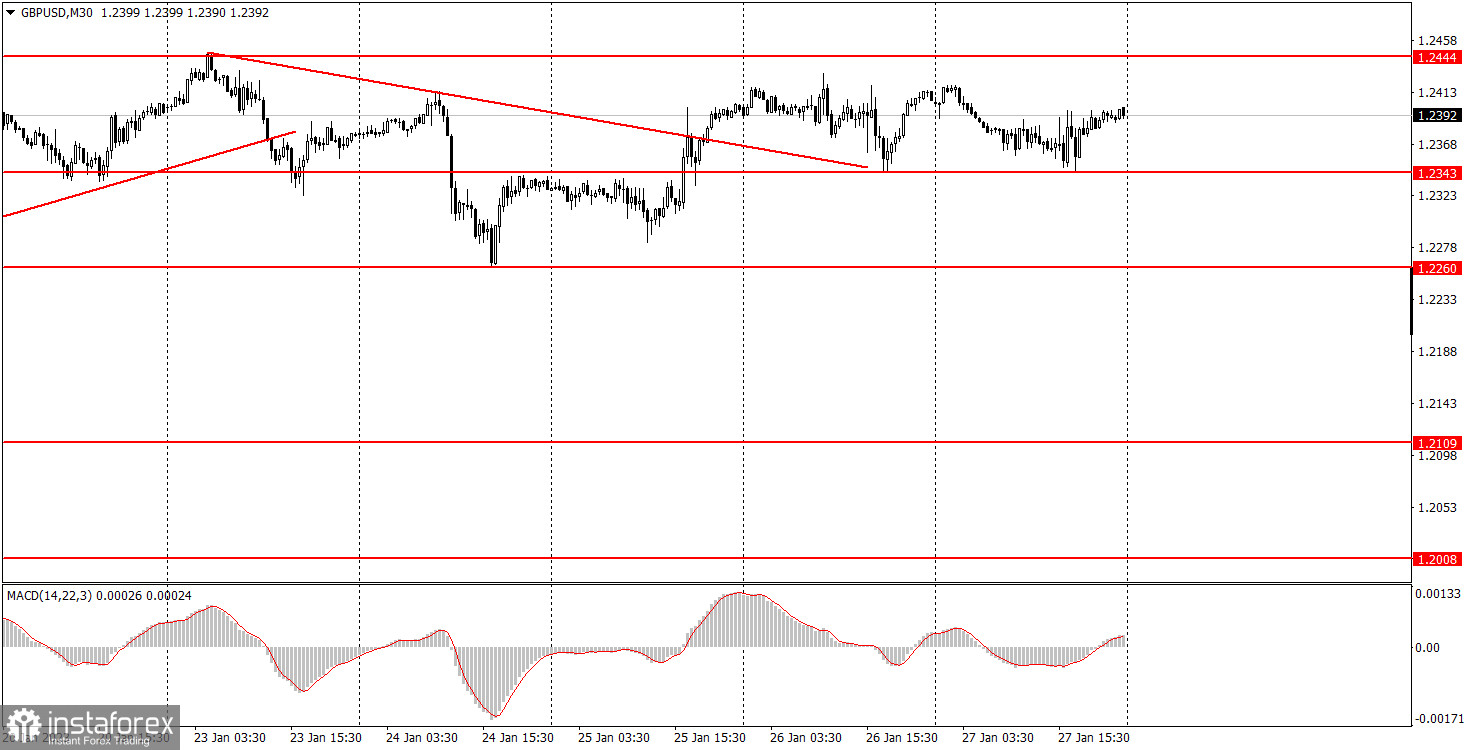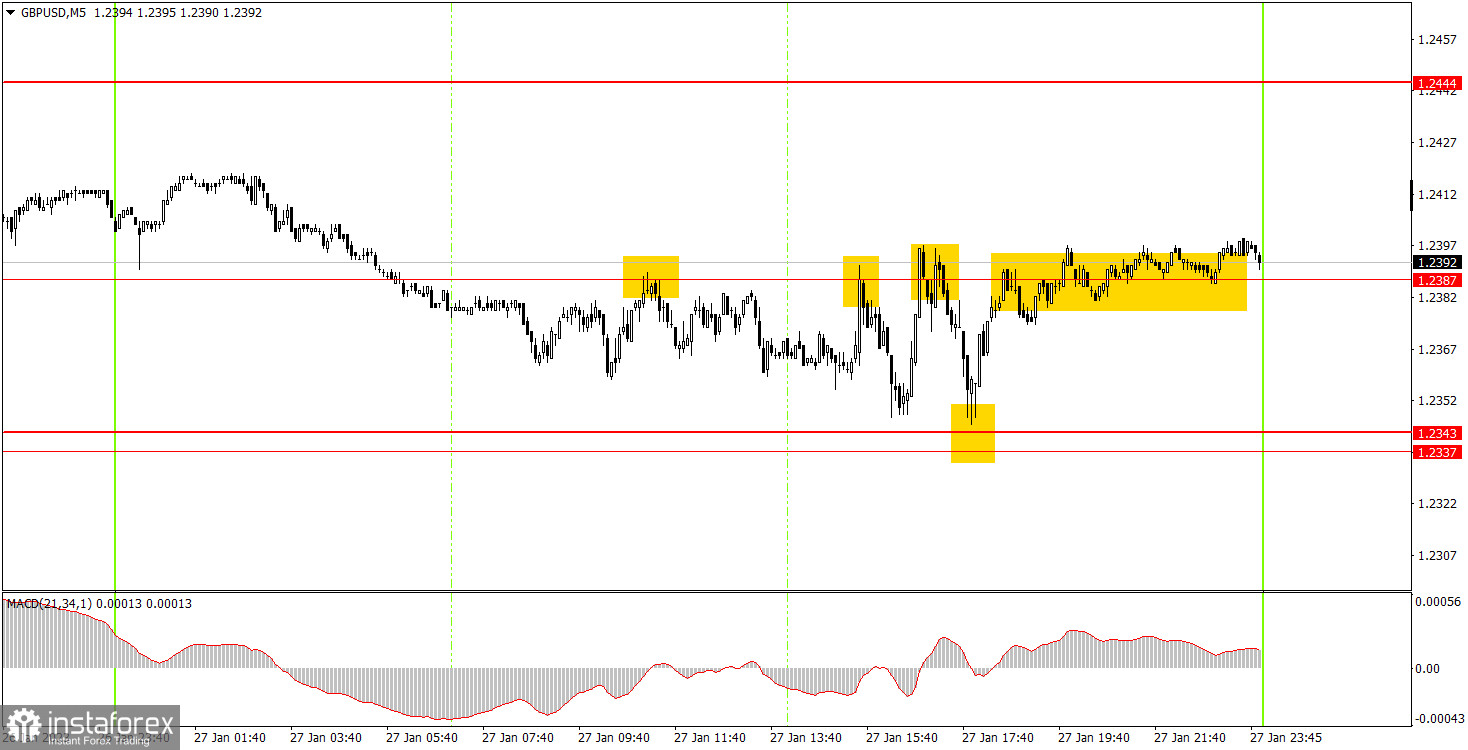Analyzing Friday's trades:
GBP/USD on 30M chart

GBP/USD traded sideways again on Friday. The price has been between 1.2260 and 1.2444 for eight days. The range isn't tiny, but this is what we would like to focus our attention on. There is no clear flat, the price goes up and down now, but there is no clear direction either, and the uptrend persists in the long term. In general, the technical picture is highly unappealing, complex and confusing. The fact that the price overcame the descending trend line on the 30-minute chart is irrelevant. On Friday, the price once again failed to settle below 1.2343. The US macro data did not have any impact on the pair's movement. So now we just have to wait for the most important events of the next week, which should rock the market a bit and determine the direction of the trend movement.
GBP/USD on M5 chart

On the 5-minute chart, you can see that the pair was between 1.2343 and 1.2387 for almost the entire day. In other words, there is no doubt about the intraday flat. The price rebounded several times from the upper or lower limit of that range and reached the opposite one almost every time. In each case, the price moved at least 20 points in the direction the signal was received. That is why none of the open trades ended in a loss. It was possible to "steal" 40 points or so. In any case, the day could have been worse, since there is always a high probability of forming false signals and getting losses in a flat.
Trading tips on Monday:
On the 30-minute chart, GBP/USD quickly came out of the downtrend and continues to move sideways with low volatility. Next week everything could and should be solved for the British currency because there will be a lot of important events and the market is unlikely to be able to ignore them. On the 5-minute chart, it is recommended to trade at the levels 1.2109, 1.2171-1.2179, 1.2245-1.2260, 1.2337-1.2343, 1.2387, 1.2444-1.2471, 1.2577-1.2597. As soon as the price passes 20 pips in the right direction, you should set a Stop Loss to breakeven. No important events scheduled for in the UK and US, but the following days of the week will be full of them. Therefore, all the most interesting things will start on Wednesday and last until Friday.
Basic rules of the trading system:
1) The strength of the signal is determined by the time it took the signal to form (a rebound or a breakout of the level). The quicker it is formed, the stronger the signal is.
2) If two or more positions were opened near a certain level based on a false signal (which did not trigger a Take Profit or test the nearest target level), then all subsequent signals at this level should be ignored.
3) When trading flat, a pair can form multiple false signals or not form them at all. In any case, it is better to stop trading at the first sign of a flat movement.
4) Trades should be opened in the period between the start of the European session and the middle of the US trading hours when all positions must be closed manually.
5) You can trade using signals from the MACD indicator on the 30-minute time frame only amid strong volatility and a clear trend that should be confirmed by a trendline or a trend channel.
6) If two levels are located too close to each other (from 5 to 15 pips), they should be considered support and resistance levels.
On the chart:
Support and Resistance levels are the levels that serve as targets when buying or selling the pair. You can place Take Profit near these levels.
Red lines are channels or trend lines that display the current trend and show in which direction it is better to trade now.
The MACD indicator (14, 22, and 3) consists of a histogram and a signal line. When they cross, this is a signal to enter the market. It is recommended to use this indicator in combination with trend patterns (channels and trendlines).
Important announcements and economic reports that can be found on the economic calendar can seriously influence the trajectory of a currency pair. Therefore, at the time of their release, we recommend trading as carefully as possible or exiting the market in order to avoid sharp price fluctuations.
Beginners on Forex should remember that not every single trade has to be profitable. The development of a clear strategy and money management is the key to success in trading over a long period of time.
 English
English 
 Русский
Русский Bahasa Indonesia
Bahasa Indonesia Bahasa Malay
Bahasa Malay ไทย
ไทย Español
Español Deutsch
Deutsch Български
Български Français
Français Tiếng Việt
Tiếng Việt 中文
中文 বাংলা
বাংলা हिन्दी
हिन्दी Čeština
Čeština Українська
Українська Română
Română

